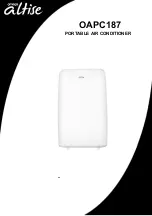
7
5. Electrical work
Fig. 5-1
5.1. Electric wiring (Fig. 5-1)
* Make sure all electrical wiring is complete before installing the cover panel.
1. Secure the provided sheet metal for conduit with provided screws to the side of
the unit (two screws).
2. Remove the cover from the address board (two screws).
3. Remove the cover from the electrical box (one screw).
4. Remove the screws securing the electrical box and lower the box (two screws).
5. Insert the wires into the electrical box.
6. Connect the wires securely to the terminal block.
* Be sure to make the various wires long enough so the box may be lowered from
the unit during servicing.
7. Secure the wires with the wiring clamp on the side of the electrical box.
8. Replace the parts you have removed to their original locations.
A means for the disconnection of the supply with an isolation switch, or similar de-
vice, in all active conductors shall be incorporated in the fixed wiring.
Power supply wiring
Power cable size (diameter) : more than 1.6 mm (AWG14)
Ground cable size (diameter) : 1.6 mm (AWG14)
* Use copper supply wires.
* Use the electric wires over the rating voltage 300 V.
* Instalation must be in accordance with the Natronal Electrical code (NEC) and all
appliciable codes. Field wiring material used must have a VW1 flame rating.
5.2. Connecting remote controller, indoor and outdoor
transmission cables (Fig. 5-2)
Pass the transmission cable and remote controller cable through the provided glass
tube and then secure both ends of the tube with the provided bands.
• Connect indoor unit TB5 and outdoor unit TB3. (Non-polarized 2-wire)
The “S” on indoor unit TB5 is a shielding wire connection. For specifications about
the connecting cables, refer to the outdoor unit installation manual.
• Install a remote controller following the manual supplied with the remote controller.
• Connect the remote controller’s transmission cable within 33 ft (10 m) using a
0.75 mm
2
core cable. If the distance is more than 33 ft (10 m), use a 1.25 mm
2
junction cable.
1
MA Remote controller
• Connect the “1” and “2” on indoor unit TB15 to a MA remote controller. (Non-polar-
ized 2-wire)
• DC 9 to 13 V between 1 and 2 (MA remote controller)
2
M-NET Remote controller
• Connect the “M1” and “M2” on indoor unit TB5 to a M-NET remote controller. (Non-
polarized 2-wire)
• DC 24 to 30 V between M1 and M2 (M-NET remote controller)
A
Terminal block for indoor transmission cable
B
Terminal block for outdoor transmission cable
C
Remote controller
Constraints on transmission cable (Fig. 5-3)
Longest wiring length (L
1
+L
2
+L
4
or L
1
+L
3
or L
2
+L
3
+L
4
): less than 656 ft (200 m)
Length between indoor unit and remote controller (
R
): within 33 ft (10 m)
G
Outdoor unit
H
Earth
I
BC controller
J
Indoor unit
K
M-NET Remote controller
L
Non-polarized 2-wire
Note:
*1 Put the transmission cable earth via the outdoor unit’s earth terminal
to
the ground.
*2 If the remote controller cable exceeds 33 ft (10 m), use a 1.25 mm
2
(AWG16)
diameter cable over the exceeded portion, and add that exceeded portion
to within 656ft (200 m).
*3 The BC controller is required only for simultaneous cooling and heating
series R2.
5.3. Setting addresses (Fig. 5-4)
(Be sure to operate with the main power turned OFF.)
• There are two types of rotary switch setting available: setting addresses 1 to 9 and
over 10, and setting branch numbers.
1
How to set addresses
Example: If Address is “3”, remain SW12 (for over 10) at “0”, and match SW11(for
1 to 9) with “3”.
2
How to set branch numbers (Series R2 only)
Match the indoor unit’s refrigerant pipe with the BC controller’s end connection
number. Remain SW14 other than R2 at “0”.
• The rotary switches are all set to “0” when shipped from the factory. These switches
can be used to set unit addresses and branch numbers at will.
• The determination of indoor unit addresses varies with the system at site. Set them
referring to technical data.
Note:
Please set the switch SW5 according to the power supply voltage.
• Set SW5 to 230 V side when the power supply is 230 volts.
• When the power supply is 208 volts, set SW5 to 208 V side.
Fig. 5-2
1
2
A
A
C
TB5
TB15 TB5
TB15
S
M1 M2
S
M1 M2
B
TB3
M1 M2
2
1
C
2
1
A
A
C
TB5
TB5
S
M1 M2
S
M1 M2
C
B
TB3
M1 M2
A
Cover
B
Electrical box
C
Terminal block for power supply
D
Terminal block for transmission cable
E
Control board
F
Address board
G
Secure with the wiring clamp
H
Terminal block for MA Remote controller
I
Plate for conduit
J
Screw (M4
×
12)
K
Glass tube
L
Band
A
F
B
I
J
C
E
F
H
L
K
D
G
Fig. 5-3
A
Fig. 5-4
G
I
J
J
J
K
K
K
K
J
J
L
K
H
*1
*3
L1
L2
L4
r
L3
*2
SW14
0
SW11
0
SW12
0
1 2 3 4 5 6 7 8 9 10
ON
OFF
SW1
SW5
220V
(208V)
240V
(230V)
SWC
CN82
CN43
Summary of Contents for Air-Conditioners For Building Application
Page 11: ......






























